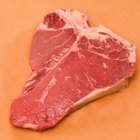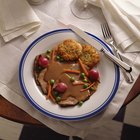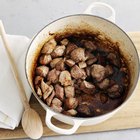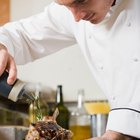
Large roasts and holiday turkeys are almost always prepared in large metal roasting pans, which provide enough room for the entree and its cooking juices. Smaller birds and roasts can be prepared in a wider range of pans, from lightweight foil to ceramic casserole dishes. Many cooks use tempered glass roasting pans or casserole dishes for these smaller meals, either because of its special characteristics or because it's a family tradition. Glass pans are different from metal, and require some adjustments.
Keeping Your Temper
Glass bakeware and cookware is usually referred to as "tempered" glass, because it's been strengthened to increase its resistance to shattering. Ordinary glass is made by heating silica -- essentially, a pure form of sand -- until it becomes liquid. Heatproof glass or laboratory glass is usually referred to as borosilicate, because the silica has oxides of boron added to it. It expands less when heated, making it resistant to shattering. Other tempered glass is made by adding lime to the silica, and pre-stressing to counter the effects of heat. This type of glass is less robust but also much less costly, so most modern glass cookware uses silica-lime glass.
Now You're Cooking With Glass
Some materials, such as aluminum, are valued for cooking because of their ability to conduct heat quickly and efficiently. Others are used for exactly the opposite reason, because they retain heat. Glass bakeware, like cast iron, falls into the second category. Once heated, it stubbornly retains its temperature, giving foods an even, all-round exposure to the heat. This can be a definite positive when roasting, though smart cooks know to make a few adjustments.
Change of Pace
One of the most notable characteristics of glass roasting pans is their ability to brown your roasts. The heat trapped in the borosilicate radiates against the meat, as if the oven walls had moved to just a few inches away. This creates richly browned roasts and gives your chickens a crisp, golden skin, but it's also possible to have too much of a good thing. Most cooks turn down their oven's heat by 25 degrees Fahrenheit to compensate for the browning effect, and keep the meal from getting too dark. A glass roaster will also keep cooking the meat after it's removed from the oven, because of its heat retention, so remove your roast or bird to a serving tray immediately.
Fragile as Glass
Although tempered glass roasters are tough and durable, they can still break if they're mishandled. Glass is famously fragile, and glass cookware is no exception. Although it's thick, it will still break if it's dropped or banged into a hard object. A glass roaster hot from the oven is likely to shatter violently if you pour in room-temperature water, or set it down on a cold surface. Using steel-wool scouring pads or metal utensils can scratch the surface, creating grooves that trap moisture and cause the glass to shatter when it's heated. Still, if you bear those limitations in mind while you work, good-quality glass cookware can last for generations.
Related Articles

Can You Pour Boiling Water Into a ...

What Is Better for Cookware: Glass, ...
How to Lower Cooking Times & ...

Glass Pie Pan Baking Tips

How to Broil Strip Steak

Are Nickel Lined Pans Safe?

What Is Magnalite?

How to Cook a Beef Sirloin Tip Roast ...

Does a Roaster Oven Cook Faster Than ...

Is Revere Ware Aluminum?

How to Use an Electric Roaster to Slow ...

How to Cook a Rib Eye Steak in a Glass ...

Titanium Vs. Tourmaline Flat Irons

Can Ceramic Cookware Be Used on ...

What Are the Benefits of Stoneware ...

Is Corning Cookware Safe?

Can You Cook Frozen Dinners in Glass?

Can I Make a Cake Mix in a Ceramic Dish?

What "Tools of the Trade" Cookware is ...
Convection Broiling Vs. Convection ...
References
- On Food and Cooking: The Science and Lore of the Kitchen; Harold McGee
- World Kitchen: Pyrex 4-Qt Glass Roaster -- Use & Care
- Cookware Manufacturers Association: Guide to Cookware and Bakeware
Writer Bio
Fred Decker is a trained chef and prolific freelance writer. In previous careers, he sold insurance and mutual funds, and was a longtime retailer. He was educated at Memorial University of Newfoundland and the Northern Alberta Institute of Technology. His articles have appeared on numerous home and garden sites including GoneOutdoors, TheNest and eHow.
Photo Credits
Creatas/Creatas/Getty Images